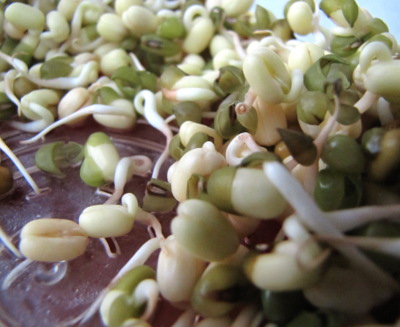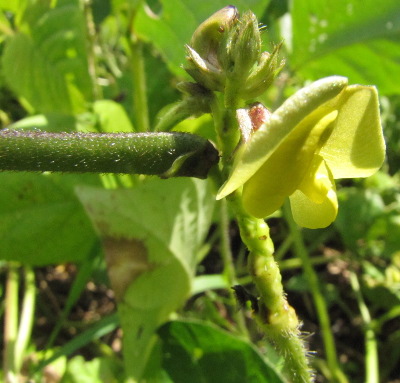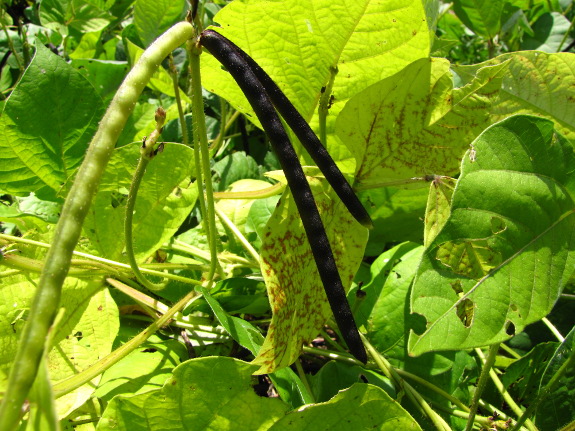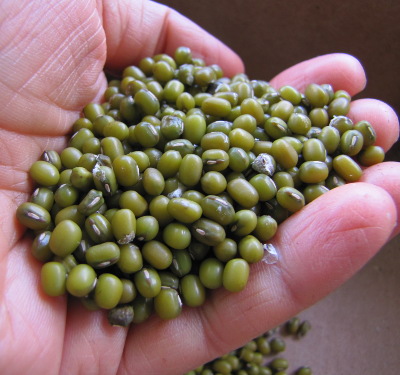
How to grow sprouting beans
 Mark and I both enjoy the
flavor of bean sprouts, so of course we wanted to produce our
own. First I experimented with urd
beans, which grew
beautifully and turned out to be semi-self-shelling, but were iffy to eat ---
the duds went rock hard and tended to get mixed in with the sprouts,
damaging teeth.
Mark and I both enjoy the
flavor of bean sprouts, so of course we wanted to produce our
own. First I experimented with urd
beans, which grew
beautifully and turned out to be semi-self-shelling, but were iffy to eat ---
the duds went rock hard and tended to get mixed in with the sprouts,
damaging teeth.
Since mung beans are the
variety you see in most stores, I figured they might be a better
option. Finding the seeds was tough...until I realized that I
could simply buy some beans for sprouting and germinate them in the
soil instead of in the kitchen.
 I'm glad I changed varieties
because our mung beans have been even more productive than the urd
beans were. (It's not really a fair comparison, though, since the
urd beans got nibbled by deer and the mung beans didn't.)
I'm glad I changed varieties
because our mung beans have been even more productive than the urd
beans were. (It's not really a fair comparison, though, since the
urd beans got nibbled by deer and the mung beans didn't.)
The one flaw in mung
beans at the growth stage is that they tend to sprawl out across the
aisles, suggesting that a small trellis might come in handy for next
year's planting. Otherwise, mung beans are one of our easiest
crops since they don't seem to have any pests and just keep plugging
right along while the cucumbers wilt, the tomatoes blight, and the
green beans get eaten by beetles. (Don't worry, we're getting
good harvests of other vegetables despite these problems --- it's just
restful to look over at the mung beans after struggling with certain
other crops.)

I do have a couple of
tidbits to help those of you who want to try growing mung beans.
First is during the harvest phase --- try to pick ripe (black) pods
once a week if you live in a damp climate so none of the beans mold.
After picking, I just
spread the beans out on a tray for a couple of days to dry the dew off,
then shell them. Mung beans will self-shell like urd beans, but
the miniature explosions make me feel like I live at a shooting range,  and the beans tend to get
strewn around in all directions, so I generally end up taking the beans
out of the pods by hand. (Yes, I can shell beans while I read.)
and the beans tend to get
strewn around in all directions, so I generally end up taking the beans
out of the pods by hand. (Yes, I can shell beans while I read.)
The other tricky part
about growing sprouting beans is eating them. Luckily, mung beans
don't seem to produce the rock-like non-sprouters that urd beans do (or
maybe I've just gotten better at sorting them out during the harvest
stage). But you need room temperature conditions to get the beans
to sprout before they mold. I kept trying to sprout beans in the
winter, because that's when we crave fresh produce, but the truth is
that in our non-climate-controlled trailer, the warmer seasons are a
better time for sprouting.
We've been enjoying
eating up last year's mung beans, but this year's harvest is even
bigger --- two cups so far with more on the vine. Looks like I
need to get creative about cooking with sprouts.
Want more in-depth information? Browse through our books.
Or explore more posts by date or by subject.
About us: Anna Hess and Mark Hamilton spent over a decade living self-sufficiently in the mountains of Virginia before moving north to start over from scratch in the foothills of Ohio. They've experimented with permaculture, no-till gardening, trailersteading, home-based microbusinesses and much more, writing about their adventures in both blogs and books.
Want to be notified when new comments are posted on this page? Click on the RSS button after you add a comment to subscribe to the comment feed, or simply check the box beside "email replies to me" while writing your comment.
- Remove comment
- Remove comment
- Remove comment
- Remove comment
